 Behavioural economists study how people’s buying, selling and other behaviour responds to various incentives and social situations. They don’t accept the simplistic notion that people are always rational maximisers. As the Livemint article below states, “According to behavioural economists, the human brain neither has the time nor the ability to process all the information involved in decision making, as assumed by the rational model.” Instead, rationality is bounded: people use simple rules of thumb in making decisions – rules they have developed over time in the light of experience.
Behavioural economists study how people’s buying, selling and other behaviour responds to various incentives and social situations. They don’t accept the simplistic notion that people are always rational maximisers. As the Livemint article below states, “According to behavioural economists, the human brain neither has the time nor the ability to process all the information involved in decision making, as assumed by the rational model.” Instead, rationality is bounded: people use simple rules of thumb in making decisions – rules they have developed over time in the light of experience.
So can people’s behaviour be altered by understanding their limited rationality? Advertisers are only too well aware of a number of psychological ‘tricks’ to change people’s purchasing behaviour. For example, wanting to be approved of by your friends is used by advertisers to sell various fashion products and toiletries. Often, people need only a relatively small ‘nudge’ to change the way they behave.
And it is not just advertisers who are using the insights of behavioural economics. Governments are increasingly trying to find ways of nudging people to behave in ways that are better for themselves or for society.

In 2010, David Cameron set up a ‘Nudge Unit’, formally know as ‘The Behavioural Insights Team‘. It has produced a number of academic papers on topics as diverse as tax compliance, incentives for university attendance, charitable giving in the workplace and using SMS reminders to reduce missed hospital appointments. The academic evidence can then be use as the basis for policy.
Another nudge unit has been set up in Australia (see second article below). The USA, Singapore and various other countries are increasingly using the insights of behavioural economics to devise policy to affect human behaviour.
Two recent pieces of work by the UK team concern ways of discouraging doctors from over-prescribing antibiotics and using encouraging text messages to FE students to reduce dropout rates. Another nudge has been used by the tax authorities (HMRC) who have been sending out texts to remind people to pay their taxes on time and to make them aware that they are being monitored. The message read, “Most people pay on time to avoid penalties”.
The articles below look at these recent initiatives and how human behaviour can be changed in a relatively low-cost way. In most cases this involves a simple nudge.
Articles
Nudge-unit trials reveal best ways to prod people Sydney Morning Herald, Nick Miller (29/8/15)
Government ‘nudge unit’ to attempt to change people’s behaviours Sydney Morning Herald, Nick Miller (15/9/16)
New frontiers of human behaviour Livemint, Biju Dominic (15/9/16)
Doctors ‘nudged’ into prescribing far fewer antibiotics New Scientist (15/9/16)
GPs handing out fewer antibiotics after warning of over-prescribing, says study BT (15/9/16)
Study of colleges shows ‘encouraging’ texts dramatically cut dropout rates FE Week, Paul Offord (22/7/15)
 The text messages getting teenagers better grades BBC Today Programme, David Halpern and Fiona Morey (15/9/16)
The text messages getting teenagers better grades BBC Today Programme, David Halpern and Fiona Morey (15/9/16)
Ping! Pay your tax now or face a penalty. HMRC sends out ‘threatening’ SMS texts to taxpayers The Telegraph, Christopher Hope (15/9/16)
Publications of Behavioural Insights Team
Publications list BIT
The Behavioural Insights Team’s Update Report: 2015–16: overview BIT (15/9/16)
The Behavioural Insights Team’s Update Report: 2015–16 BIT (15/9/16)
Blog BIT
Questions
- Explain what is meant by bounded rationality.
- Give some examples from your own behaviour of decisions made using rules of thumb.
- Should we abandon models based on the assumption of rational maximising behaviour (e.g. attempts to maximise consumer surplus or to maximise profit)?
- Find out some other examples of how people might be nudged to behave in ways that are in their own interest or that of society.
- How might people be nudged to eat more healthily or to give up smoking?
- To what extent can financial incentives, such as taxes, fines, grants or subsidies be regarded nudging? Explain.
- Why, do you think, the message by an Australian hospital, “if you attend, the hospital will not lose the $125 we lose when a patient does not turn up” was successful in reducing missed appointments by 20%, while the message, “if you do not attend, the hospital loses $125” was not as effective?
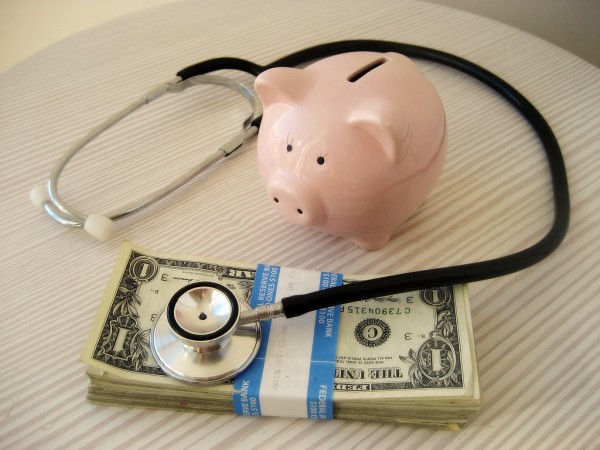 When people think about healthcare in the UK they tend to associate it with the NHS. However, there is a £5 billion private healthcare market. Concerns have been expressed about the lack of effective competition in this sector and it has been investigated by the competition authorities over a 5-year period.
When people think about healthcare in the UK they tend to associate it with the NHS. However, there is a £5 billion private healthcare market. Concerns have been expressed about the lack of effective competition in this sector and it has been investigated by the competition authorities over a 5-year period.
Approximately 4 million people in the UK have a private medical insurance policy. The majority of these are paid for by employers, although some people pay directly. Four companies dominate the health insurance market (AXA PPP, Bupa, Pru Health and Aviva) with a combined market share of over 90%.
Health insurance companies purchase healthcare services for their policy holders from private hospitals. The majority of private hospitals in the UK are owned by the following businesses – BMI, HCA, Nuffield, Ramsey and Spire. Some concerns have been expressed about the lack of competition between private hospitals in some areas of the country.
After its initial analysis into the sector, the Office of Fair Trading (OFT) referred the case to the Competition Commission (CC) in April 2012 to carry out a full market investigation. This process was then taken over by the Competition and Markets Authority (CMA) when it replaced the OFT and CC. The final report was published on April 2nd 2014.
One specific region that was identified in this report as having a lack of effective competition was central London for patients with health insurance. In particular it was concluded that:
|
|
| • |
The market in central London was heavily concentrated and HCA had a dominant market position – its aggregated share of admissions across 16 specialities (e.g. Oncology, Cardiology, Neurology, Dermatology etc.) was 45% to 55%. |
| • |
There were significant barriers to entry including substantial sunk costs. A particular issue for a new entrant or existing business was the problem of securing suitable sites in central London to build new hospitals and in obtaining planning permission. It was pointed out in the report that the market structure in central London had changed very little in the previous 10 years despite a rapidly growing demand for private healthcare. |
| • |
HCA was charging insured patients higher prices for similar treatments than its leading rival – The London Clinic. HCA was also found to be making returns that were in excess of the cost of capital. |
One of the key recommendations of the report was that HCA should be forced to sell–off one or two of the hospitals that it owned in central London to increase the level of competition.
Unsurprisingly HCA was very unhappy with the decision and applied to the Competition Appeal Tribunal (CAT) for a review of the case. During this review, economists working for HCA found errors with the analysis carried out by the CMA into the pricing of health services for insured customers.
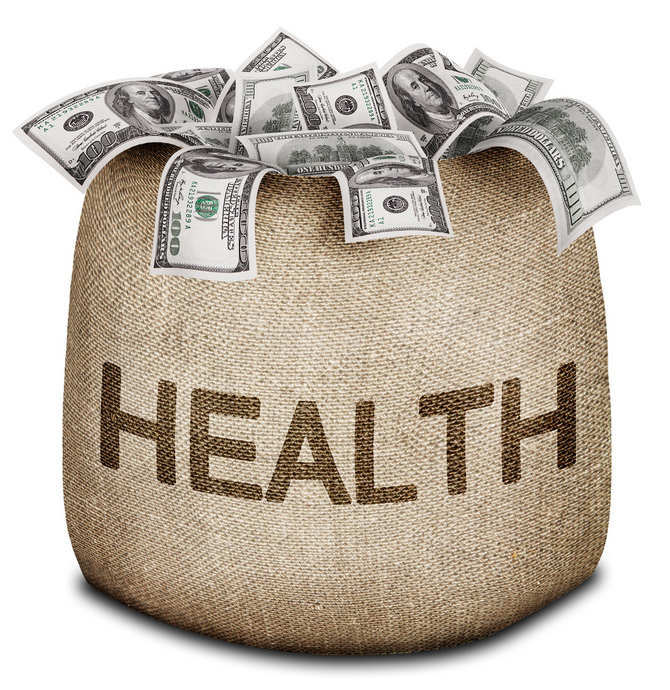
In January 2015 the CAT concluded that the findings and recommendations of the report on insured patients in central London should be overturned and the CMA should reconsider the case. In November 2015 the CMA announced that having reviewed the case it had come to a similar set of conclusions: i.e. there was a lack of effective competition and HCA should be forced to sell off two of its hospitals in London.
HCA still claimed that the pricing analysis was incorrect because it did not fully take into account that HCA treated patients with more complex conditions than TLC and that was why their prices were higher.
On March 22nd 2016 the CMA announced that it had reversed its ruling and HCA would no longer be expected to sell off any of its hospitals. The reason given for this change in recommendation was the appearance of new entrants into the market. For example, Cleveland Clinic a US-based private healthcare provider has purchased a long-term lease on a property in Belgravia, central London. It plans to convert the office space into a private hospital with 2015 beds.
A spokesperson for Bupa commented that:
“The CMA has confirmed again that there isn’t enough competition in central London, with HCA dominating the private hospital market and charging higher prices. We ask the CMA to act now to address this gap.”
It will be interesting to see the impact these new entrants have on the market in the future.
Articles
London develops as a global healthcare hub Financial Times Gill Plimmer (31/01/16)
Competition watchdog reverses ruling on private hospitals Financial Times Gill Plimmer, (22/03/16)
CMA’s private healthcare provisional decision on remedies CMA 22/03/16
Competition problems provisionally found in private healthcare CMA 10/11/15
CMA welcomes Court of Appeal verdict in private healthcare case CMA 21/05/15
Questions
- Define sunk costs using some real-world examples.
- Why might the existence of sunk costs create a barrier to entry?
- Draw a diagram to illustrate why a profit-maximising business with significant market power might charge higher prices than one in a very competitive environment.
- What is the cost of capital? Explain why returns that are greater than the cost of capital might be evidence that a firm is making excessive profits.
- Draw a diagram to illustrate the impact of new entrants in a market.
 A number of famous Business Schools in the UK and US such as MIT Sloan, NYU Stern and Imperial College have launched new programmes in business analytics. These courses have been nicknamed ‘Big Data finishing school’. Why might qualifications in this area be highly valued by firms?
A number of famous Business Schools in the UK and US such as MIT Sloan, NYU Stern and Imperial College have launched new programmes in business analytics. These courses have been nicknamed ‘Big Data finishing school’. Why might qualifications in this area be highly valued by firms?
Employees who have the skills to collect and process Big Data might help firms to successfully implement a pricing strategy that approaches first-degree price discrimination.
First-degree price discrimination is where the seller of a product is able to charge each consumer the maximum price he or she is prepared to pay for each unit of the product. Successfully implementing this type of pricing strategy could enable a firm to make more revenue. It might also lead to an increase in economic efficiency. However, the strategy might be opposed on equity grounds.
In reality, perfect price discrimination is more of a theoretical benchmark than a viable pricing strategy. Discovering the maximum amount each of its customers is willing to pay is an impossible task for a firm.
It may be possible for some sellers to implement a person-specific pricing strategy that approaches first-degree price discrimination. Firms may not be able to charge each customer the maximum amount they are willing to pay but they may be able to charge different prices that reflect customers’ different valuations of the product.
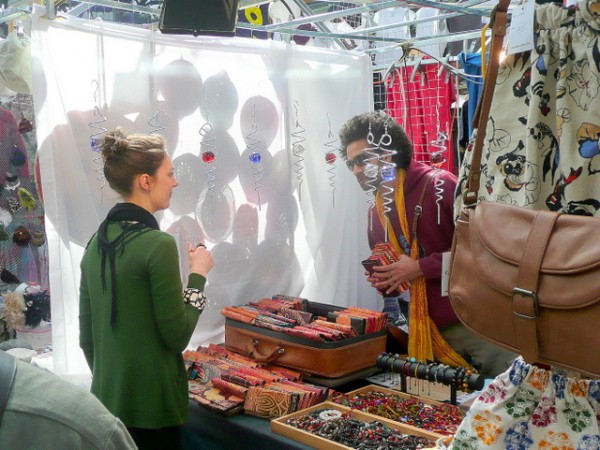 How could a firm go about predicting how much each of its customers is willing to pay? Traditionally smaller sellers might try to ‘size up’ a customer through individual observation and negotiation. The clothes people wear, the cars they drive and their ethnicity/nationality might indicate something about their income. Second-hand car dealers and stall-holders often haggle with customers in an attempt to personalise pricing. The starting point of these negotiations will often be influenced by the visual observations made by the seller.
How could a firm go about predicting how much each of its customers is willing to pay? Traditionally smaller sellers might try to ‘size up’ a customer through individual observation and negotiation. The clothes people wear, the cars they drive and their ethnicity/nationality might indicate something about their income. Second-hand car dealers and stall-holders often haggle with customers in an attempt to personalise pricing. The starting point of these negotiations will often be influenced by the visual observations made by the seller.
The problem with this approach is that observation and negotiation is a time-consuming process. The extra costs involved might be greater than the extra revenue generated. This might be especially true for firms that sell a large volume of products. Just imagine how long it would take to shop at a supermarket if each customer had to haggle with a member of staff over each item in their supermarket trolley!! There is also the problem of designing compensation contracts for sales staff that provide appropriate incentives.
However the rise of e-commerce may lead to a very different trading environment. Whenever people use their smart phones, laptops and tablets to purchase goods, they are providing huge amounts of information (perhaps unconsciously) to the seller. This is known as Big Data. If this information can be effectively collected and processed then it could be used by the seller to predict different customers’ willingness to pay.
Some of this Big Data provides information similar to that observed by sellers in traditional off-line transactions. However, instead of visual clues observed by a salesperson, the firm is able to collect and process far greater quantities of information from the devices that people use.
For example, the Internet Protocol (IP) address could be used to identify the geographical location of the customer: i.e. do they live in a relatively affluent or socially deprived area? The operating system and browser might also indicate something about a buyer’s income and willingness to pay. The travel website, Orbitz, found that Apple users were 40 per cent more likely to book four or five star hotel rooms than customers who used Windows.
Perhaps the most controversial element to Big Data is the large amount of individual-level information that exists about the behaviour of customers. In particular, browsing histories can be used to find out (a) what types of goods people have viewed (b) how long they typically spend on-line and (c) their previous purchase history. This behavioural information might accurately predict price sensitivity and was never available in off-line transactions.
Interestingly, there has been very little evidence to date that firms are implementing personalised pricing on the internet. One possible explanation is that effective techniques to process the mass of available information have not been fully developed. This would help to explain the growth in business analytics courses offered by universities. PricewaterhouseCoopers recently announced its aim to recruit one thousand more data scientists over the next two years.
Another possible explanation is that firms fear a backlash from customers who are deeply opposed to this type of pricing. In a widely cited survey of consumers, 91% of the respondents believed that first-degree price discrimination was unfair.
Articles
Big data is coming for your purchase history – to charge you more money The Guardian, Anna Bernasek and DT Mongan (29/5/15)
Big data is an economic justice issue, not just a Privacy Problem The Huffington Post, Nathan Newman (16/5/15)
MIT’s $75,000 Big Data finishing school (and its many rivals) Financial Times, Adam Jones (20/3/16)
The Government’s consumer data watchdog New York Times, Natasha Singer (23/5/2015)
The economics of big data and differential pricing The Whitehouse blog, Jason Furman, Tim Simcoe (6/2/2015)
Questions
- Explain the difference between first- and third-degree price discrimination.
- Using an appropriate diagram, explain why perfect price discrimination might result in an economically more efficient outcome than uniform pricing.
- Draw a diagram to illustrate how a policy of first-degree price discrimination could lead to greater revenue but lower profits for a firm.
- Why would it be so difficult for a firm to discover the maximum amount each of its customers was willing to pay?
- Explain how the large amount of information on the individual behaviour of customers (so-called Big Data) could be used to predict differences in their willingness to pay.
- What factors might prevent a firm from successfully implementing a policy of personalised pricing?
 As most developed countries continue to experience relatively low rates of economic growth by historical standards, governments and central banks struggle to find means of stimulating aggregate demand.
As most developed countries continue to experience relatively low rates of economic growth by historical standards, governments and central banks struggle to find means of stimulating aggregate demand.
One explanation of sluggish growth in demand is that people on higher incomes have enough of most things. They have reached ‘peak stuff’. As the Will Hutton article linked below states:
Around the developed world consumers seem to be losing their appetite for more. Even goods for which there once seemed insatiable demand seem to be losing their lustre. Last week, mighty Apple reported that in the last three months of 2015 global sales of the iPhone stagnated, while sales of iPads tumbled from 21m units in 2014 to 16m in the same three months of 2015. In the more prosaic parts of the economy – from cars to home furnishings – there are other warnings that demand is saturated.
People on lower incomes may still want more, but with income inequality growing in most countries, they don’t have the means of buying more. Indeed, a redistribution from rich to poor may be an effective means of increasing aggregate demand and stimulating economic growth.
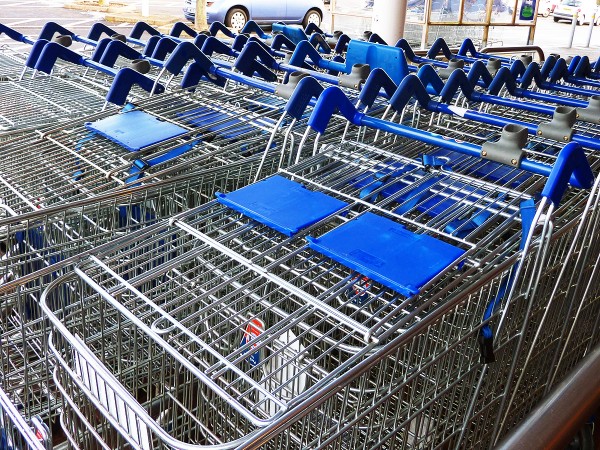 It’s important to clarify what is meant by peak demand for such products. It is not being said that people will stop buying them – that future demand will be zero. People will continue to buy such products. In the case of durables, people will buy replacements when products such as furniture, fridges and cars wear out; or upgraded versions as new models of televisions, smartphones or, again, cars come out; or new music tracks or films as they become available for download, or clothing as new fashions appear in shops. In the case of foodstuffs, concerts, football matches and other consumables, they too will continue to be purchased. The point is, in the case of peak demand, the demand per period of time is not going to grow. And the more products there are that reach peak demand, the harder it will be for companies and economies to grow.
It’s important to clarify what is meant by peak demand for such products. It is not being said that people will stop buying them – that future demand will be zero. People will continue to buy such products. In the case of durables, people will buy replacements when products such as furniture, fridges and cars wear out; or upgraded versions as new models of televisions, smartphones or, again, cars come out; or new music tracks or films as they become available for download, or clothing as new fashions appear in shops. In the case of foodstuffs, concerts, football matches and other consumables, they too will continue to be purchased. The point is, in the case of peak demand, the demand per period of time is not going to grow. And the more products there are that reach peak demand, the harder it will be for companies and economies to grow.
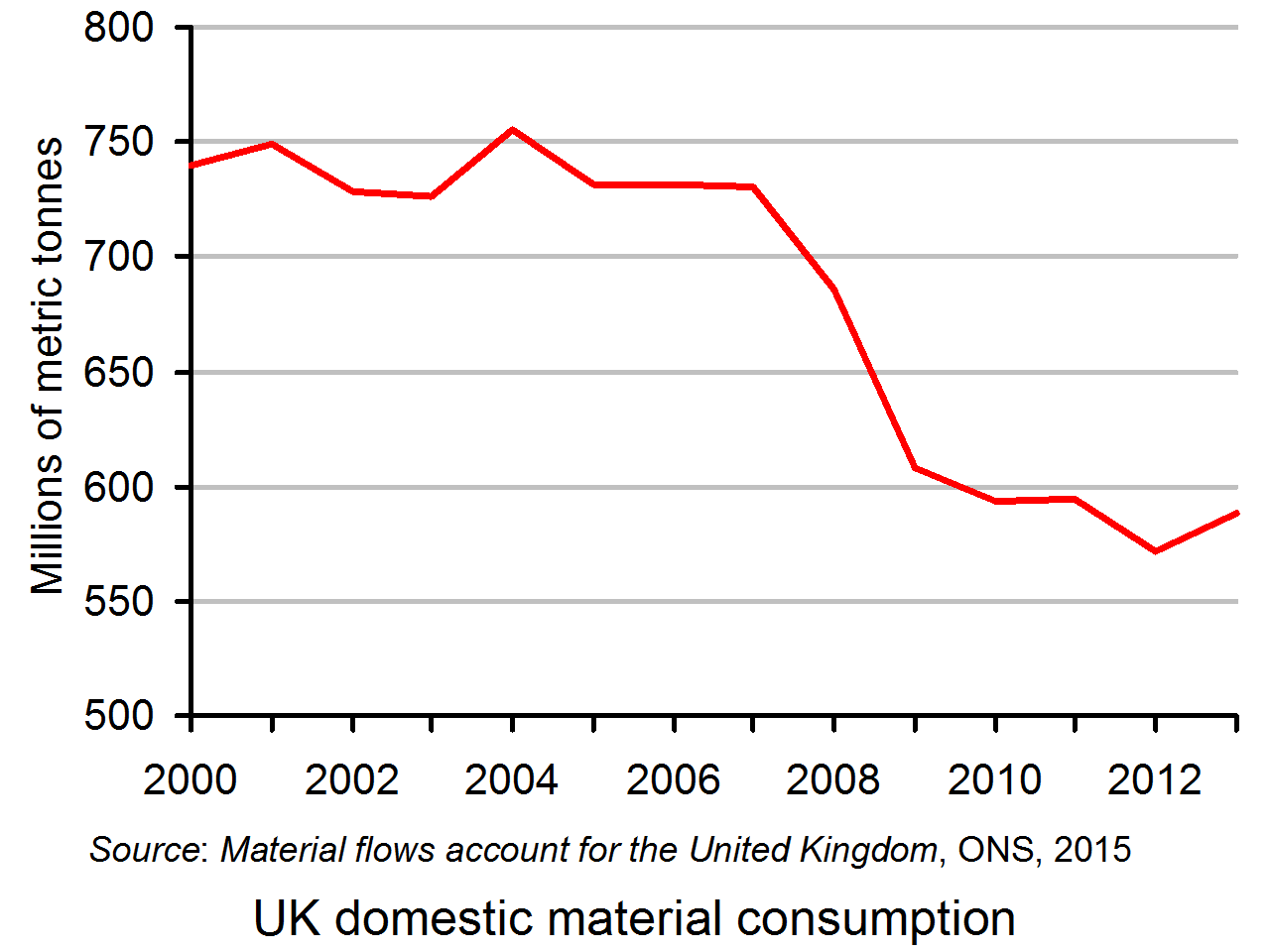 If peak demand has generally been reached, it is likely that the demand for material resources will also have peaked. Indeed, we could expect the demand for material resources to be declining as (a) there has also been an increase in the efficiency of production, so that a lower volume of material inputs is required to produce any given level of output and (b) there has been a general switch towards services and away from physical goods. The graph shows domestic material consumption in the UK in millions of metric tonnes. Domestic material consumption is defined as domestic extraction of resources minus exports of resources plus imports of resources. As you can see, domestic material consumption peaked in 2004.
If peak demand has generally been reached, it is likely that the demand for material resources will also have peaked. Indeed, we could expect the demand for material resources to be declining as (a) there has also been an increase in the efficiency of production, so that a lower volume of material inputs is required to produce any given level of output and (b) there has been a general switch towards services and away from physical goods. The graph shows domestic material consumption in the UK in millions of metric tonnes. Domestic material consumption is defined as domestic extraction of resources minus exports of resources plus imports of resources. As you can see, domestic material consumption peaked in 2004.
But, although peak demand may have been reached in some markets, there are others where there is still the potential for growth. To understand this and identify where such markets may be, it is important to step back from simple notions of consumption to satisfy materialistic demand and focus on the choices people might make to increase their happiness or wellbeing or sense of self worth in society. Thus while we might have reached peak red meat, peak sugar, peak cars, peak furniture and even peak electronic gadgets, we have not reached peak demand for more satisfying experiences. The demand for education, health, social activities, environmental conservation and a range of fulfilling experiences may have considerable potential for growth.
There are business opportunities here, whether in the leisure industry, in building networks of like-minded people or in producing niche goods that satisfy the demands of people with specific interests. But without greater equality there may be many fewer business opportunities in the mass production industries producing standardised goods.
This is not a world in which goods and services are produced at scale as conventionally measured, but a honeycomb economy of niches and information networks whose new dynamics we barely understand, even if we have a better grasp of its values.
Articles
- If having more no longer satisfies us, perhaps we’ve reached ‘peak stuff’
The Guardian, Will Hutton (31/1/16)
- Steve Howard, Ikea Exec, Says The World Has Hit ‘Peak Stuff’
Huffington Post, Zi-Ann Lum (20/1/16)
- We’ve hit peak home furnishings, says Ikea boss
The Guardian, Sean Farrell (18/1/16)
- Peak stuff: the ‘growth’ party is over. So what next?
The Ecologist, Bennet Francis and Rupert Read (22/1/16)
- Have we reached peak ‘stuff’?
The Mancunion, Tristan Parsons (22/2/16)
- Ikea senses room to grow amid ‘peak stuff’
Financial Times, Aliya Ram and Richard Milne (18/1/16)
- Peak Stuff
ifs insights, Janet Hontoir (21/2/16)
- UK retail sales soar as Brits splash their cash on ‘fun stuff’
The Telegraph, Szu Ping Chan (19/2/16)
- How less stuff could make us happier – and fix stagnation
The Guardian, Katie Allen (26/4/16)
Questions
- What are the implications of countries reaching ‘peak stuff’ for (a) the marginal utility of mass produced goods; (b) the marginal propensity to consume and the multiplier?
- Give some examples of goods or services where peak stuff has not been reached.
- If peak stuff has only been reached for certain products, does this mean that there may still be considerable potential for stimulating aggregate demand without a redistribution of income?
- Would it be in the interests of companies such as Asda to make a unilateral decision to pay their workers more? Explain why or why not.
- Why may we be a long way from reaching peak demand for housing, even without a redistribution of income?
- Make out a case for and against tax cuts as a way of stimulating (a) economic growth and (b) a growth in wellbeing? Do your arguments depend on which taxes are cut? Explain.
- The Ecologist article states that “Attaining one-planet living will probably involve in due course achieving degrowth in countries such as ours: building down our economy to a safe level.” Could such an objective be achieved through a mixed market economy? If so, how? If not, why not?
- Does the Telegraph article suggest that peak stuff has not yet been reached as far as most UK consumers are concerned?
 Recent reports in the media have included headlines such as “Sexist surcharge” and “Pink premium?” Various claims have been made that women pay significantly higher prices for similar products than men.
Recent reports in the media have included headlines such as “Sexist surcharge” and “Pink premium?” Various claims have been made that women pay significantly higher prices for similar products than men.
The Times newspaper recently published the results from an investigation it carried out on the prices of hundreds of similar products that were marketed at both men and women. The study found that those products marketed at women cost 37% more on average than similar versions that were marketed at men. Examples included:
- Disposable razors: Tesco priced a packet of five of its own-brand disposable razors for women at £1. The key characteristic that targeted the razors at female customers was the colour – they were pink. For the same price, a packet targeted at male customers (i.e. they were blue) contained 10 disposable razors.
- Ballpoint pens: Staples priced a packet of five pastel-coloured Bic pens marketed ‘for her’ at £2.99. A packet of five Bic pens that were not in the ‘for her’ range (i.e. they had transparent barrels) were priced at £1.98.
- Scooters: Argos increased the price of a child’s scooter by £5 if it was pink instead of blue.
Maria Miller, the chair of the Women and Equalities Select Committee, stated that:
“It is unacceptable that women face higher costs for the same product just because they are targeted at women. Retailers have got to explain why they do this.”
A more detailed study carried out by New York City’s Department of Consumer Affairs was published in December 2015. Average prices were collected for 794 individual items across 5 different industries. The key findings were that products marketed at women were:
- 7 per cent more for toys and accessories
- 4 per cent more for children’s clothing
- 8 per cent more for adult clothing
- 13 per cent more for personal care products
- 8 per cent more for health products
Interestingly whereas the investigation in the UK only found examples of women paying higher prices than men, the New York study found some goods where the price was higher for men.
Reports in the media have claimed that this is clear evidence of price discrimination. Although this is likely to be true, it is impossible to say for certain without more detailed information on costs.
For example, when referring to the higher price for the razors marketed at women in the UK study, Richard Hyman, an analyst at RAH Advisory, stated that:
“the packaging will be different and they will sell fewer so it could be to do with the volume”
If economies of scale and the different costs of packaging can fully account for the difference in prices between the razors then it is not an example of price discrimination.
Articles
Questions
- Define price discrimination.
- Outline and explain the three different categories of price discrimination.
- Could a situation where a firms charges all of its customers the same price for a good or service ever be classed as an example of price discrimination?
- A firm with market power may still not be able to successfully implement a policy of price discrimination. Explain why.
- Under what circumstances could price discrimination improve allocative efficiency?
 Behavioural economists study how people’s buying, selling and other behaviour responds to various incentives and social situations. They don’t accept the simplistic notion that people are always rational maximisers. As the Livemint article below states, “According to behavioural economists, the human brain neither has the time nor the ability to process all the information involved in decision making, as assumed by the rational model.” Instead, rationality is bounded: people use simple rules of thumb in making decisions – rules they have developed over time in the light of experience.
Behavioural economists study how people’s buying, selling and other behaviour responds to various incentives and social situations. They don’t accept the simplistic notion that people are always rational maximisers. As the Livemint article below states, “According to behavioural economists, the human brain neither has the time nor the ability to process all the information involved in decision making, as assumed by the rational model.” Instead, rationality is bounded: people use simple rules of thumb in making decisions – rules they have developed over time in the light of experience. The text messages getting teenagers better grades BBC Today Programme, David Halpern and Fiona Morey (15/9/16)
The text messages getting teenagers better grades BBC Today Programme, David Halpern and Fiona Morey (15/9/16)







